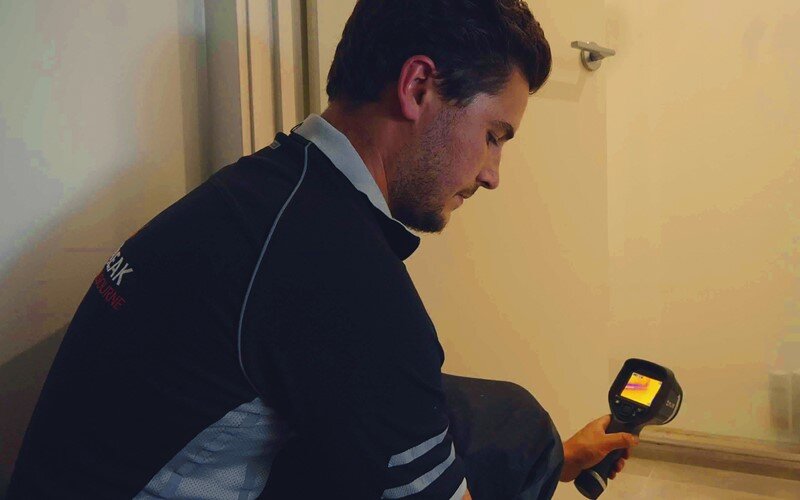How to Check If Your House Has a Concealed Leakage
How to Check If Your House Has a Concealed Leakage
Blog Article
They are making several great points on the subject of Finding hidden leaks as a whole in the article down below.

Early detection of leaking water lines can mitigate a prospective calamity. Apart from conserving you money, it will reduce the irritation and disappointment. The moment you find a leakage, calling your plumber for fixings is the best service. Some tiny water leakages might not be noticeable. Below are some hacks that help if you can not find it with your naked eyes.
1. Analyze the Water Meter
Checking it is a guaranteed way that aids you uncover leakages. If it moves, that indicates a fast-moving leak. This suggests you may have a slow leakage that could even be underground.
2. Examine Water Consumption
Evaluate your water costs and also track your water consumption. As the one paying it, you need to discover if there are any type of discrepancies. If you detect sudden changes, in spite of your usage coinciding, it implies that you have leakages in your plumbing system. Bear in mind, your water bill ought to fall under the same array every month. An unexpected spike in your bill shows a fast-moving leak.
On the other hand, a consistent rise monthly, despite having the exact same routines, shows you have a slow leak that's also gradually escalating. Call a plumber to completely examine your building, especially if you feel a cozy location on your flooring with piping beneath.
3. Do a Food Coloring Test
When it comes to water consumption, 30% comes from toilets. If the shade in some way infiltrates your bowl during that time without flushing, there's a leak in between the container and also bowl.
4. Asses Outside Lines
Do not forget to inspect your outside water lines too. Test faucets by connecting a garden pipe. Should water permeate out of the connection, you have a loose rubber gasket. Replace this as well as guarantee all links are tight. It will help get it expertly checked out and kept annually if you've got a sprinkler system. One small leak can throw away lots of water as well as surge your water bill.
5. Analyze the scenario as well as check
Property owners ought to make it a routine to check under the sink counters and also inside cabinets for any type of bad odor or mold and mildew growth. These 2 red flags show a leak so timely focus is called for. Doing regular examinations, even bi-annually, can conserve you from a significant trouble.
Examine for discolorations and also deteriorating as a lot of pipes and home appliances have a life expectations. If you think dripping water lines in your plumbing system, do not wait for it to rise.
Early discovery of leaking water lines can reduce a potential disaster. Some little water leakages might not be noticeable. Examining it is a proven means that assists you discover leakages. One tiny leakage can squander lots of water and increase your water costs.
If you think dripping water lines in your plumbing system, don't wait for it to escalate.
WARNING SIGNS OF WATER LEAKAGE BEHIND THE WALL
PERSISTENT MUSTY ODORS
As water slowly drips from a leaky pipe inside the wall, flooring and sheetrock stay damp and develop an odor similar to wet cardboard. It generates a musty smell that can help you find hidden leaks.
MOLD IN UNUSUAL AREAS
Mold usually grows in wet areas like kitchens, baths and laundry rooms. If you spot the stuff on walls or baseboards in other rooms of the house, it’s a good indicator of undetected water leaks.
STAINS THAT GROW
When mold thrives around a leaky pipe, it sometimes takes hold on the inside surface of the affected wall. A growing stain on otherwise clean sheetrock is often your sign of a hidden plumbing problem.
PEELING OR BUBBLING WALLPAPER / PAINT
This clue is easy to miss in rooms that don’t get much use. When you see wallpaper separating along seams or paint bubbling or flaking off the wall, blame sheetrock that stays wet because of an undetected leak.
BUCKLED CEILINGS AND STAINED FLOORS
If ceilings or floors in bathrooms, kitchens or laundry areas develop structural problems, don’t rule out constant damp inside the walls. Wet sheetrock can affect adjacent framing, flooring and ceilings.
https://www.servicemasterbyzaba.com/blog/how-to-detect-water-leakage-in-walls/

I have been very occupied with Leaking water lines and I hope you appreciated the new article. In case you enjoyed our post kindly remember to share it. I enjoy reading our article about Hacks to detect leaks.
Report this page